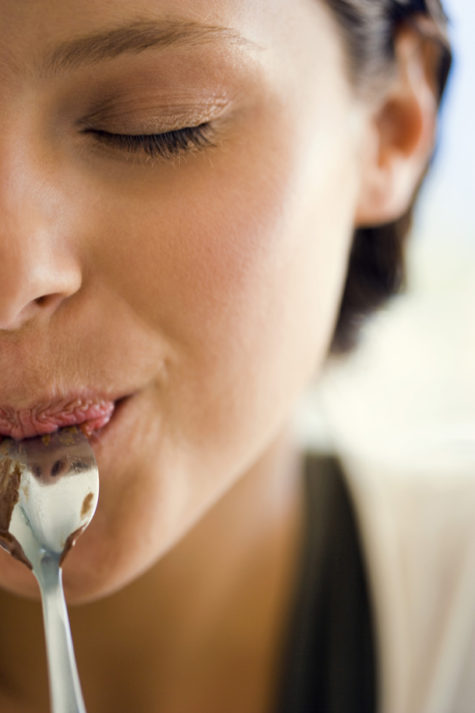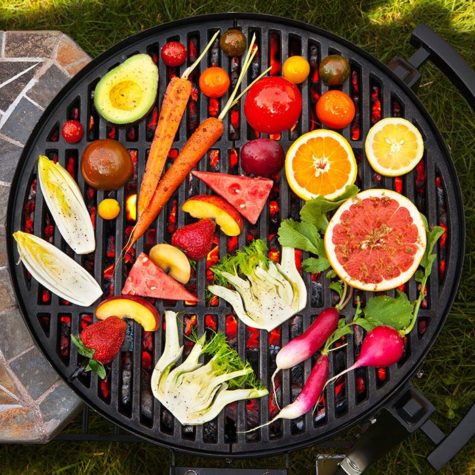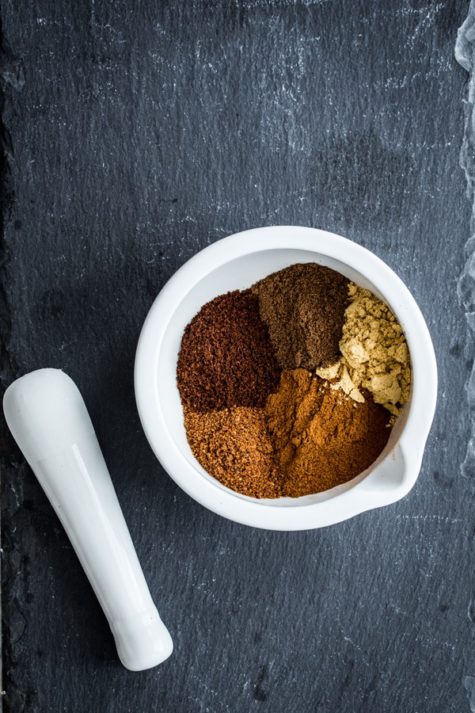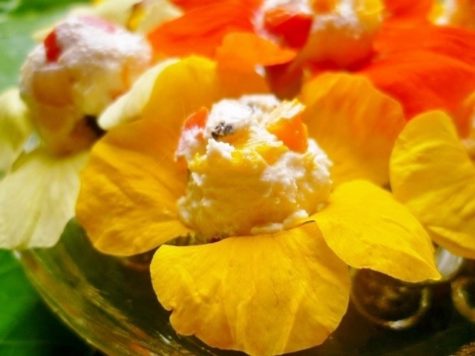Simple
Lilac Syrup
Pour over pancakes, add as a liquor base, or a nonalcoholic lemonade base. The extra syrup can be frozen in mason jars to keep year round. It is quite simple to make:
- 1 cup of water
- 1 cup of sugar
- 1 cup of lilac flowers (stems and green parts removed)
Combine the water and sugar over medium heat on the stove. Heat until dissolved. Add the lilac flowers and simmer for 10 minutes. If you want a brightly hued syrup, add about five blueberries. The color will pop and add a great dimension to your cocktails. Remove from heat, drain through a sieve, bottle, and store in the refrigerator.
From: Holly and Flora
Lilac Honey
Fill a jar (1/2 pint, pint, quart etc.) with freshly picked flowers with a little room at the top. Pour over honey to the top and cap. Allow to infuse for at least 6 weeks. No need to strain afterwards – eat the flowers along with the honey! Great for adding to recipes, spreading on bread, or adding to teas.
Note: Always use raw, unfiltered honey. Use local honey whenever possible.
From: The Practical Herbalist
Hot Milk Before Bed
A cup of hot milk before bed sets the stage for smooth transition into sleep. It soothes the nerves and, if you prepare it just right, it is tasty and full of nutrients. According to AyurVeda, milk is balancing to vata and pitta doshas.
Here’s a recipe to make your own delicious treat:
Boil the milk. Watch milk carefully until it boils, then let it continue to boil on low for about 5-10 minutes. Add spices (if desired).
- Turmeric reduces inflammation.
- Cardamom aids in digestion and adds sweetness.
- Cinnamon and ginger stimulate digestion and add a spicy kick.
- Vanilla flavor is also a delicious choice.
Pour the milk into your mug or cup of choice. Let sit until no longer scalding.
Optional:
After the milk cools completely, a teaspoon of honey or maple syrup can be added for sweetness. You can also add a half teaspoon of ghee (clarified butter).
Drink your milk and enjoy!
Note:
Milk does increase kapha dosha, which can cause weight gain, but this effect is lessened by using 2% or skim milk in place of whole milk. Hot milk pacifies vata dosha in the body and mind, allowing one to settle down for sleep.
In addition to these ayurvedic benefits, milk also supplies:
- Calcium, which keeps bones and teeth healthy and helps your body maintain bone mass
- Protein, a good source of energy that builds and repairs your muscle tissue
- Potassium, which helps maintain good blood pressure
- Phosphorus:, which strengthens your bones and gives you energy
- Vitamin D, which maintains bone density
- Vitamin B12, which maintains healthy red blood cells and nerve tissue
- Vitamin A which maintains the immune system, normal vision and good skin
- Niacin, which improves metabolism
Tonight, try boiling a cup of milk and feel the benefits for yourself. It may take a few tries to find the exact balance of spices you enjoy, but once you discover your favorites you will have a tasty new way to unwind in the evenings.
Grilling Fruits and Vegetables
Grilling fruits and vegetables is not hard. You just need to have a clean grill, thoroughly washed fruits and vegetables and you can do whatever you want with them. You can cook them right off the grill or you can use sticks or a grilling pan. Vegetables will cook better if brushed with quality oil and sprinkled with fresh herbs. The natural sugars of fruits will be more pronounced when grilled because they will be caramelized with an added smoky flavor. Who wouldn’t want that, right? Below are some fruits and vegetables that you can grill at your next barbecue.
- Apples
The humble apple can be grilled too. Apples when cook becomes more delicious when cooked and becomes even more delicious when grilled because the heat sweetens and soften the fruit. Cut into thick slices and place directly on the grill. Sprinkle some cinnamon sugar before removing the apples from the grill and you’re all set.
- Artichoke
Halve 6 baby artichokes, and brush with olive oil. Grill cut-side-down 6 minutes. Turn, and sprinkle with 1 Tbs. each minced garlic, rosemary, and thyme. Grill 4 minutes more.
- Asparagus
Steamed or blanched asparagus is good, but grilling adds more punch to it. Lightly char the asparagus over the grill, toss them in a bowl after and add some extra virgin olive, a bit of chili flakes, salt and pepper to add more taste to it.
- Avocado
Want to make some smoky guacamole? Cut the avocados in half and grill them for 2 minutes on each side. Follow your favorite guacamole recipe and enjoy it with your preferred chips.
- Banana
Place banana on grill with skin intact. Turn it until it is deep brown all the way around. Cut open, to reveal the baked banana. Serve with cold whipped cream and a touch of cinnamon for contrasting temperatures, color, and flavor.
- Bell Peppers
You can grill them whole, cut in half or chunks. Roasted red and green peppers are good in salads or in an antipasto platter. You can also sprinkle them with extra virgin olive oil, salt and pepper and make a sloppy roasted pepper sandwich.
For a sizzled Red Pepper Salad, cut 2 red bell peppers into 8 wedges each, and thread onto skewers. Coat with cooking spray, and grill 12 minutes. Transfer to bowl, and toss with 1 cup cooked chickpeas, 1/2 cup chopped fresh fennel, 1 Tbs. olive oil, and 2 tsp. lemon juice.
- Berries
Here’s a recipe for a mixed Berry Compote. Combine 3 cups fresh berries with 2 tsp. light brown sugar, 1 tsp. lemon juice, and 1/2 tsp. cinnamon. Cut 2 10-inch lengths heavy-duty foil, and spoon 1 1/2 cups berry mixture onto center of each foil sheet. Fold edges together to seal packets, and grill packets 5 minutes.
- Broccoli
Toss 4 cups broccoli florets with 2 Tbs. garlic oil in bowl. Grill 6 minutes using a grid-style grill topper. Transfer broccoli to bowl, toss with 3 Tbs. prepared BBQ sauce, then grill 2 minutes more.
- Corn
Put corn with husk and silk intact on the grill away from flames. Turn periodically – about 15 minutes. Shuck the corn and remove the silk. Eaten as is, roasted corn has a rustic smoky flavor.
You can pull the husk off and grill with butter and salt. Grill it for about 5-7 minutes. A bit of char will add to its smoky flavor as compared to leaving the husk when grilling.
Tasty toppings range from the expected butter and sea salt to the more interesting serving suggestions I learned from my Latino friends. Squeeze the juice of a lemon or lime on the corn in place of salt. Try a dash of ground red pepper, a splash of hot sauce or a sprinkle of Parmesan cheese to take it from a side dish to a main course. This is a vegetarian delight.
- Eggplant
Eggplants are versatile and every eggplant growing nation have made some eggplant grilling for decades. When grilled, the outer skin becomes crispy and the insides creamy. You can cut them crosswise or lengthwise and coat them with some extra virgin olive oil, salt and pepper and cook for 6 minutes or until the eggplant is tender. You can dip it in marinara sauce or malt vinegar or blue cheese. The possibilities are endless.
- Green Beans
They are wonderful when grilled, but will slide down or slip through the grill. The solution? Go get a grill basket. You can cook these slender vegetables without losing or burning one of them. After cooking, just toss them in a bowl, sprinkle some extra virgin olive oil, salt, pepper and a bit of butter to make everything nice and tasty.
Alternatively, you can thread string beans onto skewers (don’t crowd them too tightly). Brush with garlic oil; grill 4 minutes on each side.
- Nectarines
Cut them in half, drizzle them with a bit of extra virgin olive oil and sprinkle some brown sugar after grilling. It’s just like taking a bite of heaven.
For nectarine halves with goat cheese and pistachios, grill 4 pitted nectarine halves 5 minutes on each side. Top with 1 tsp. soft goat cheese, 1 Tbs. honey, and 2 tsp. toasted chopped pistachios.
- Peaches
Fresh peaches are good, canned peaches are great desserts, but grilled peaches are heavenly. One great thing about grilled peaches are when you take a bite, you will get a chutney-like texture which can compliment grilled chicken or steak. If you have a sweet tooth, you can grill peaches and sprinkle with cinnamon sugar.
- Pineapple
Grilling pineapple reduces its sourness or acidity, but enhances its sweetness because the fruit is caramelized and its natural sugar adds to its sweetness. It’s just like eating hot, fruity candy.
Peel pineapple; slice width-wise in 1/2 inch slices. You can cut them into circles or wedges and place them directly on the grill for 3 or 4 minutes on each side. If you want it to be sweeter, add a few drops of honey after grilling. Eat as an accompaniment to seafood or fish, or as a desert.
For a tequila-lime pineapple, whisk together 3 Tbs. tequila, 1 1/2 Tbs. agave nectar, 1 Tbs. lime juice, and 1/8 tsp. cayenne pepper in bowl. Add 4 fresh pineapple rings, and marinate 2 hours. Grill 7 minutes on each side. Serve with reserved marinade.
- Portobello Mushrooms
You can use these big and round mushrooms as a substitute for your ground beef patty. Portobellos have a meaty consistency which will be better if you brush it with olive oil and cook them for 7 minutes on each side.
- Squash
You can roast summer squash, such as party pan, chayote, zucchini, or hard-shelled winter squash like butternut, delicata, or acorn. Summer squash should be clean and dry. Then cook whole, slice and add to kabobs, or chop and cook inside foil with olive oil and season to taste.
Summer squash can also be cut in half, the seeds and insides removed, brushed with corn, peanut, or olive oil, and seasoned with lemon, sea salt, and pepper. Ground ginger or cinnamon goes well with winter squash as well. Place prepared winter squash halves in foil. Put them on the barbecue grill. Roast until tender, about 35 to 40 minutes.
For lemon-basil butternut slices, cut peeled butternut squash into 1/4-inch-thick slices; coat with cooking spray. Grill 20 minutes. Sprinkle with 2 Tbs. olive oil, 1 Tbs. lemon juice, 8 basil leaves, and 3 Tbs. raisins.
- Sweet Potato
Scrub the potato, rinse it, and pat it dry. Prick it with a fork. Wrap it in foil. Place it on the grill. Turn periodically. It cooks in about half an hour on a medium grill. Test for doneness; it should feel soft. Cut it open. Carve an X shape on each half. Squeeze and fluff potato. Serve warm with butter, sea salt, fresh ground pepper, cinnamon, and cayenne. Roasted Sweet potato with a dash of spice is sure to add nice warmth to a chilly evening.
For sesame sweet potatoes, cut 3 large sweet potatoes into 1/4-inch-thick slices; brush with 2 Tbs. toasted sesame oil. Grill 15 to 20 minutes, or until tender and browned.
- Tomato
Smoky salsa or a smoky tomato sauce or a smoky side for your shawarma or kebab? Slice the tomatoes in half, grill them with a bit of olive for about 3 minutes on each side and you’re done.
- Watermelon
Who would have thought that that grilling a watermelon is such a delicious experience? There’s only a few people who like their watermelons grilled, but trust those people, they did one good thing into another wonderful experience. You can add honey and some lemon juice to make more exciting or you can make a salad by mixing arugula and some balsamic dressing. Just remember, watermelon cooks fast and it’s better to cook them using indirect heat.
- Zucchini
Cut into thin slices and coat them with olive oil, salt and pepper. Grill them for 1 minute and you will have a delectable treat.
For zucchini with Parmesan and pine nuts. Halve 4 small zucchini; coat with cooking spray, and grill 15 minutes. Top with 1 1/2 oz. shaved Parmesan cheese, 1/4 cup chopped fresh mint, and 2 Tbs. toasted pine nuts.
Sources:
- Four Seasons of Mojo
- Xen Life
- Vegetarian Times
Pumpkin Pie Spice
Pumpkin Pie Spice is a blend of spices associated with the Fall season, Halloween, and Thanksgiving. It’s very easy to make.
To start, you’ll need all of three minutes and the following ingredients: 3 tablespoons ground cinnamon, 2 teaspoons ground ginger, 2 teaspoons ground nutmeg, 1 ½ teaspoons ground allspice and 1 ½ teaspoons ground cloves. Mix the spices together in a small bowl and take a little whiff. (Smells like heaven, right?) Store the mixture in a clean small jar or spice container. See? So easy.
You can customize your personal blend by bumping up the ginger and cloves, for a sharper, more robust flavor, or go light on those and amp up the cinnamon for a softer flavor. When you make it yourself, you can make it JUST right, and that’s worth doing at least once every Autumn.
Source: Betty Crocker
Candied Lemon Balm Leaves
This is a favorite kid activity around here! Beat an egg white with a tiny bit of water. Dip fresh lemon balm leaves in the mixture, then dip in sugar. Lay the coated leaves on a parchment lined baking sheet. Place the baking sheet in a 200°F oven until the leaves look dry, but not browned. Check after 20 minutes and every 5 to 10 after that.
Use to decorate ice cream, cakes, cookies, cupcakes and other confections.
Found at: The Nerdy Farm Wife
Stuffed Nasturtium Flowers
Nasturtium flowers have a wonderful peppery flavor.
Mix 8 ounces softened cream cheese with 2 Tablespoons finely minced chives or other herbs of your choice. Stuff the mixture into nasturtium flowers and place on a tray that has been lined with nasturtium leaves. Serve at room temperature.
From: Herbal Gardens
The End of All Diets

Our tendency is to eat automatically, robot-like. If the taste is not lived, we are just stuffing. Go slow and be aware of the taste. Only when you go slow can you be aware. Taste the food unhurriedly and become the taste. When you feel sweetness, become the sweetness. Then it can be felt all over the body, spreading in ripples.
When and Where:
Whatsoever and whenever you are eating, feel the taste and become the taste. When drinking water, feel the coolness. Close your eyes, drink it slowly, taste it.
Benefits:
With this technique your sensitivity grows, and you become more alive and more filled. Stuffing disappears as the whole of your body feels
filled. The more sensitive you are the more alive you are. When you are more alive, more life will enter your inner being. You will be more open.
Source: Pragito Dove
A Healing Bone Broth
Bone broth is the most accessible “cure-all in traditional households and the magic ingredient in classic gourmet cuisine, stock or broth made from bones of chicken, fish and beef builds strong bones, assuages sore throats, nurtures the sick, puts vigor in the step and sparkle in love life–so say grandmothers, midwives and healers.
For chefs, stock is the magic elixir for making soul-warming soups and matchless sauces. Stock contains minerals in a form the body can absorb easily-not just calcium but also magnesium, phosphorus, silicon, sulphur and trace minerals. It contains the broken down material from cartilage and tendons–stuff like chondroitin sulphates and glucosamine, now sold as expensive supplements for arthritis and joint pain.
It works great as a base for soups, sauces, grains, beans or add some kraut and a bit of miso for a delicious and easy lunch. A warm cup in the morning is a simple and nourishing tonic to begin the day. This is the flavor of love!
Here’s a simple recipe:
Every time you come upon a beef bone, like when you have steak, keep it. Collect leftover bones in a gallon bag in the freezer. Eventually, you’ll have enough for a pot of stock. If you like, you can buy some bones as well, or instead.
You can buy soup bones at a butcher store or your supermarket’s butcher counter. They might be labeled soup bones, marrow bones, or even “dog bones,” although people can eat them, too! If you don’t see them on display, ask the nice folks behind the counter, and they’ll set them aside to sell you when they remove them from the meat they process, or even order them for you.
Ingredients:
- Beef bones, about 3 quarts, or 3 pounds – you can use any mix of leftover bones or soup bones, marrow bones or bones sold for dogs
- Water
Equipment that bears mentioning:
- Tall stock pot (ideal), or any big pot
- Tongs
- A big bowl or another big pot
- Several freezer-safe containers
In a nutshell:
Roast bones until browning and fragrant. Simmer bones 6 to 12 hours. Cool and strain. Lift off tallow when completely cool.
Yield:
About 1 gallon.
Temperature and time:
- Oven: 350 F : 45 minutes.
- Stovetop: Low : 6 to 12 hours
In detail:
Heat water. Fill a stockpot or other large pot with water about halfway and set on the stove on high heat. It takes a while for this to get to the boil, so you might as well get it started while the bones are roasting.
Roast bones. Set oven to 350 F. Spread bones out on a shallow baking sheet or rimmed cookie sheet. Place in oven for 45 minutes, or until browned and sizzling. Don’t allow them to burn or get singed, or the whole batch will taste burnt.
Remove the pan of bones from the oven and set it near the pot. Use kitchen tongs to transfer the bones carefully into the water. The bones will be sizzling hot — up to 350 F (think about it) — so don’t drop them in so that they make a splash that could burn you. Slide or place them carefully.
Simmer bones. Add water, if there’s space in the pot, so that there approximately a gallon plus a quart of water. That’ll give you a gallon of stock, after about a quart of loss to evaporation, absorption into the bones and clinging to the bones. The precise amount of water is not important. If you don’t have a pot big enough for this amount of water and/or bone, just use less.
Bring the water to the boil. Turn the heat to the lowest setting possible that will maintain a gentle simmer. The surface of the water should be waving gently and making many tiny bubbles. It should not be frothing crazily.
Over the course of the next several hours, check the soup every hour or so to see that the simmer level is good.
After six to twelve hours, turn off the heat. The amount of time depends on your convenience. You could cook this overnight, but the strong cooking aroma might disturb your sleep, despite being wonderful.
Cool and strain. Let the stock cool. This will take an hour or two. Pour the stock through a strainer into a big bowl or another big pot.
Skim tallow. If desired, cool it long enough that you can easily lift the tallow (beef fat) that has collected and solidified atop the liquid. Store this separately in the refrigerator. It makes an excellent, stable and tasty cooking fat with a high smoke point.
Store stock. Ladle the stock into individual containers and store in refrigerator or freezer.
Variations:
- Use any other kind of animal bones you like, chicken especially will take less time due to smaller pieces.
- Add a splash of vinegar when simmering the bones. (The acidity will help extract more minerals from the bones).
- Add chopped veggies like carrots, celery and onions for more flavor or variety.
A crock pot makes this recipe super-simple, but you can also use a large stock pot (hence the name) or an enameled cast-iron dutch oven type of pot.
Recipe from: How To Cook With Vesna
Simple Boiled Noodles
Pasta is made from grain and can be used as a base for a meal. When using noodles with reduced or no wheat, use the shock method. Buckwheat (soba), corn, and rice noodles are delicate. Shocking allows the noodles to cook thoroughly and gently. The cold water temporarily halts the cooking of the outside of the noodles so the inside of the noodles can catch up.
- 4 quarts of water for up to 16 ounces of noodles
- ¼ tsp sea salt for 4 quarts of water, for unsalted noodles
Procedure – Bring water to a boil. Add sea salt if needed. Add noodles and stir to separate them. Bring to a rolling boil. Add ½ cup cold water and stir noodles. Bring to a rolling boil a second time. Immediately, add ½ cup cold water and stir noodles. Bring to a rolling boil a third time. Add ½ cup cold water and stir noodles. Bring to a rolling boil again. Noodles are done when they are the same color inside and out. Drain. Rinse in cold water. Drain. Rinse and drain again, if needed, until noodles are cooled.
Yield: 5 to 6 cups per 8 ounces of noodles
Source: Ohsawa Macrobiotics











